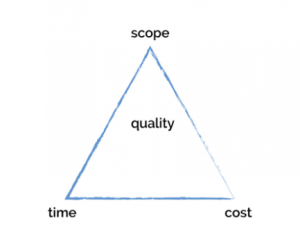Agile Triangle
Learn the essence of the Agile Project Management Triangle.
Browse topics
All Agile software development projects are created with specific goals in mind. Something needs to be delivered by a certain date, within the framework of a certain budget. You also have to find a balance between these three parameters — value, quality, and constraint. And, you know, it might not be easy.
Let’s take the triangle limitation of planning that has served humankind for decades as a guideline, and see how the right balance of these parameters helps Agile teams to feel happy about Agile project management and succeed in Agile at scale.

What Is the Traditional Iron Triangle?
The traditional project management conception offers the Iron Triangle of Time, Cost, and Scope (or, in some cases, Time, Cost, and Quality). People involved in Agile admit that, for traditional projects, scope tends to be fixed or prioritized, while time and cost are more mutable. The project will add time and budget to reach scope objectives.
The model of the Iron Triangle constraints of project management is considered “iron” as we can not change one constraint without impacting others.
The roots lead to 1969 when Dr. Martin Barnes proposed the original iron triangle that followed a Waterfall approach to product development — the scope was fixed, and resources and time were variable. It meant that teams defined product requirements first to determine a project’s scope. Schedules and resources are variable. They are estimated depending on the fixed scope.
The Concept of the Iron Triangle
The concept of the Iron Triangle is based on 3 variables and one dependent one. The three independent variables are Scope, Time, and Cost. The dependent variable is Quality. The formula is:
Quality = f (Scope, Time, Cost)
- Scope is about the volume of work assigned.
- Time is about the duration available to do it.
- Cost refers to the number of resources you want to devote to the task.
- Quality is about the resultant quality of the output.
The combination of the 3 factors shows how your product may vary in quality enormously.
Software development evolved in the 21st century, and the need for the ability to respond quickly to clients’ feedback and better collaboration became crucial. That is why the Agile methodology was born.
The Way How Agile Triangle Can Work for Your Projects
- Project Value. It should be measured by stakeholders and reflect what they expect.
- Quality. It means that you can deliver a product by adapting to the needs of your clients.
- Constraints. The elements of the Iron Triangle — project scope, schedule, and cost — appear here.
Therefore, the Agile Triangle can be actually beneficial, flexible, and more adaptable to the whole project and teams.
Why Apply the Agile Triangle
When agility is about delivering customer value by being flexible, then the natural question appears: How can a Traditional Iron Triangle be the best way to measure performance? It can’t, so it is worth considering the Agile Triangle that is focused on quality, value, and constraints.
The Iron Triangle includes scope, scheduling, and cost to deliver quality. Agile wants teams to be flexible concerning the project scope and schedules. Additionally, they need to stay within the cost of the project to deliver the end result. What will happen if you try the new Agile Triangle?
Scope vs Value
The project scope defines and outlines the projects. The value of the project contains the scope at many levels, so you have to think about both project scope and value as well as how well your team can adapt. Agile management is about flexibility. However, too much flexibility can lose the value of your project or even result in a failed outcome.
Schedule vs Constraints
Project schedules require fast and hard rules. However, changes will always happen. Identifying constraints will help with the schedules and timelines within your project. The Agile Triangle considers applying constraints to redefine scheduling.
Cost vs Quality
When you utilize the Iron Triangle, a good project scope, schedule, and cost factors measure a project’s quality. Quality should not be the end-all of the project in the Agile Triangle. It should allow for flexible cost structures to reach the required effect and quality.

Three Vertices of the Agile Triangle
1. Product Owner
The Product Owner (PO) is responsible for the overall business processes. He/she provides the user requirements to the teams.
During the sprint cycle, PO may push user stories to the teams. The stories can be unplanned during sprint planning meetings or can be out of the queue.
2. Scrum Master
Scrum Master (SM) ensures that the team is following all Agile practices properly. He/she acts as a facilitator between the PO and the entire team. Additionally, SM makes sure that the Product Owner is not compelling the team to manage the stories that are out of the queue.
3. Team
Developers, UX/UI, testers, database architects, system architects, and some more members represent the team. They are responsible for coding, designing, testing, reviewing, and deploying the product. They prepare user stories and give the timeline for completing them.
If these vertices of the Agile Triangle work with each other, then the value, quality, and constraints of the Triangle can be maintained and the outcome can be a successful product.
Agile Triangle in use
Despite everything we’ve described above, there are some experts who claim that there is no such thing as an Iron Triangle in Agile. But why?
They say that it is impossible to fit projects into tiny flexible boxes. They add that there are more than 3 elements to consider when implementing Agile management. The Agile Triangle is the thing that has helped to sway these doubters through implementation.
Let’s consider the example of Jim Highsmith. He uses Agile for his projects — the first was Motorola’s Iridium project that failed in the marketplace. Then it was James Cameron’s movie Titanic that was over-cost and over-schedule.
- Motorola’s project stayed within the scope, schedule, and cost (even though it failed at the marketplace). That is why it was successful.
- Titanic, on the other hand, had overruns as high as $200 million. However, the movie gained $ 1 billion at the box office. Though monetarily successful, it didn’t use good Agile management techniques.
Conclusion
Regardless of the differences between the Waterfall model and Agile development, there is no right or wrong way to use triangle constraints. It is needed so that you can make the best decisions and correctly prioritize to reach your business goals.
Hygger.io clearly shows the components of a plan: workload, people, and time. It provides teams with real-time scheduling capabilities. You can easily experiment with workloads, teams, and timelines when planning your next product release by analyzing team data in Hygger.

